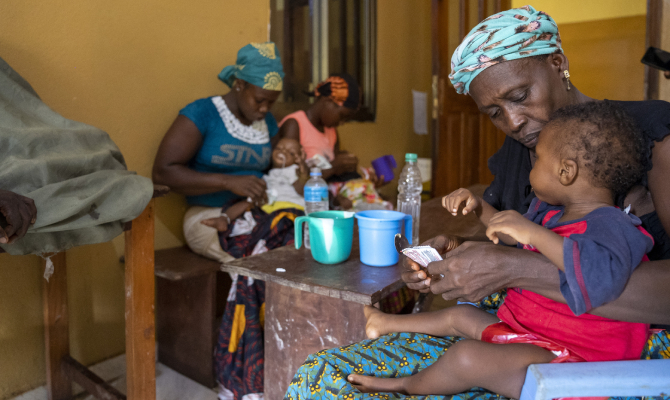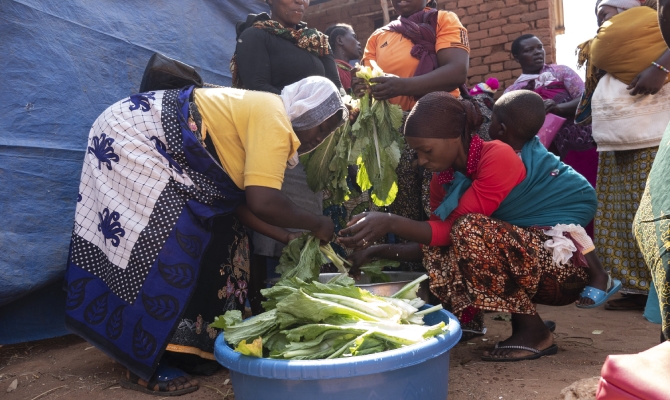World Food Day is celebrated every year on October 16 to commemorate the founding of FAO, the United Nations Food and Agriculture Organization, established in Québec, Canada, in 1945. The date has now become a global event aimed at raising public awareness about one of the most urgent challenges of our time: ensuring fair and sustainable access to food for all. This year’s message, chosen to draw attention to the 733 million people facing hunger worldwide, is “The Right to Food for a Better Life and Future.”
«I arrived at the emergency room cause the baby could not stop vomiting, had diarrhea and high fever. When we got admitted, they diagnosed a severe malnutrition and gave her oxygen. We stayed 24h at the emergency department before being transferred to the paediatric ward where my baby started the treatment with therapeutic milk first and later with PlumpyNut» said Christine from Pujehun, Sierra Leone.
Lack of access to food and poor diet leads directly to malnutrition, currently affecting 2.8 billion people worldwide (UNICEF, WHO, World Bank Group, 2023). This remains a chronic issue in some areas of the world and contributes to 45% of global deaths among children under the age of 5. In sub-Saharan Africa, several factors contribute to the high malnutrition rates: armed conflicts, climate shocks, and economic crises, all of which severely impact the poorest and most vulnerable populations.
Malnutrition is caused by a lack of essential nutrients. Children who suffer from it experience stunted growth and poor physical and mental development. Furthermore, due to weakened immune systems, they are highly vulnerable to infections and diseases.
«Most of our patients are malnourished – says Annachiara Zin, CUAMM pediatrician in Pujehun, Sierra Leone. The district’s economic situation, lack of food availability, and poor education on the issue are risks factors that compound the prevalence of malnutrition cases, significantly affecting infant mortality. We often receive critical patients who arrive with complications that could have been prevented with timely intervention» adds Zin. This reminds us that an integrated approach is necessary, acting both clinically, with dedicated hospital services, and at the community level, building trust and facilitating access to health services.»
The 1,000 days from the beginning of a woman’s pregnancy to her child’s second birthday are some of the most critical for human nutrition and growth. However, at-risk groups more generally include children under five, adolescents, pregnant or breastfeeding women, the elderly, and those with chronic illnesses. The most vulnerable people are often forced to consume only basic or low-cost foods—often poorly nutritious—while others lack access to fresh or diverse food items or do not have the necessary information to adopt a healthy diet.
In Pujehun district, Sierra Leone, Doctors with Africa CUAMM carries out initiatives to prevent and treat malnutrition that combine clinical and community-based activities. With the aim of eradicating hunger, achieving food security, and improving nutrition, CUAMM promotes sustainable agriculture through the creation of vegetable gardens and training sessions on good agricultural practices, designed in collaboration with the Ministry of Agriculture and Forestry. This agricultural activity is complemented by food education and sensitization activities. Cooking demonstrations held at community level aim at helping mothers in ensuring their babies a healthy and balanced diet by using nutritious, affordable, and accessible foods. To complete the community-based approach, a microcredit system managed at the community level has been introduced in 60 villages to ensure the sustainability of agricultural practices. When properly managed, agriculture, forestry, and fishing can provide nutritious food and generate adequate incomes, supporting people-centered rural development while also protecting the environment.
CUAMM’s commitment to preventing and treating malnutrition extends to all the countries in which it operates. To accelerate progress toward Sustainable Development Goal – Zero Hunger (Goal 2) of the 2030 Agenda, CUAMM supports national policies and programs by actively promoting nutrition education in communities, clinics, and health centers. They educate pregnant women, raise awareness about the benefits of exclusive breastfeeding for the first six months, and monitor children’s growth during their early years. CUAMM also addresses acute and chronic malnutrition, which remain widespread in Africa, particularly during droughts and subsequent famines.
ACUTE MALNUTRITION
Acute malnutrition results from rapid weight loss or the inability to gain weight, typically due to insufficient food access, such as in cases of famine or economic hardship. It can be moderate or severe; in severe cases, the child is at risk of death. Doctors with Africa Cuamm supports nutritional units for the intensive care of severe acute malnutrition in several hospitals in the countries where it operates, and also supports screening activities and identification of acute malnutrition cases in the field and peripheral health units.
CHRONIC MALNUTRITION
Chronic malnutrition refers to stunted growth, indicated by a low height-for-age ratio. It results from a prolonged lack of food or limited use of available resources, starting as early as the fetal stage. It causes permanent physical, mental, and intellectual deficits in children, affecting their entire future life. Unfortunately, no real therapy exists, but through specific programs, Doctors with Africa Cuamm provides educational interventions for mothers and administers supplements to pregnant women and children, which can reduce the impact and damage of stunted growth. Key interventions include treating pregnancy-related anemia, administering folic acid and other micronutrients like iodine, preventing malaria during pregnancy, promoting good maternal nutrition, exclusive breastfeeding, and deworming in children.
The fight against malnutrition is part of the Sustainable Development Goal to “End Hunger” (Goal 2) of the 2030 Agenda. However, according to estimates from UNICEF, WHO, and the World Bank, only one-third of all countries are on track to meet the global target of reducing the number of children with stunting to 89 million by 2030. With current progress, the 2030 target will be missed by 39.6 million children, with more than 80% of these being in Africa.
Support us, by donating now you help us ensuring proper malnutrition treatment to children most in need, in Sub-Saharan Africa.















